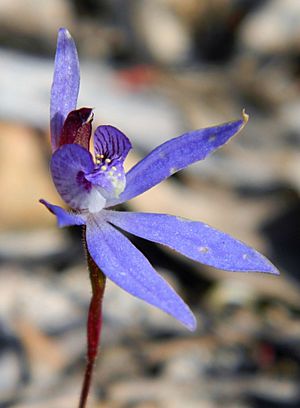Eastern tiny blue china orchid facts for kids
Quick facts for kids Eastern tiny blue china orchid |
|
|---|---|
 |
|
| Caladenia caerulea growing on Black Mountain in the A.C.T. | |
| Scientific classification | |
| Genus: |
Caladenia
|
| Species: |
caerulea
|
| Synonyms | |
|
|
The eastern tiny blue china orchid is also known as the blue caladenia or blue fairy. It is a beautiful plant that belongs to the Orchid family. This special orchid only grows in eastern Australia.
It has one thin leaf and usually just one pretty blue flower. Sometimes, the flower can even be white!
Contents
What Does the Blue Orchid Look Like?
The eastern tiny blue china orchid is a plant that grows from an underground tuber. This means it has a special part underground that stores food. It is a perennial plant, so it lives for more than two years. It is also deciduous, meaning its leaves fall off at certain times.
Its Leaf and Flower Stalk
Each orchid has a single leaf. This leaf is usually flat on the ground. It can be about 2 to 7 centimeters (about 1 to 3 inches) long. The leaf is also about 2 to 5 millimeters (less than an inch) wide. It has a few small hairs on it.
A single flower grows on a stalk. This stalk can be 5 to 15 centimeters (about 2 to 6 inches) tall. The flower itself is usually pale to dark blue. It is about 2 to 3 centimeters (about 1 inch) wide.
Parts of the Flower
Like other orchids, this one has special parts:
- The top petal, called the dorsal sepal, stands straight up. It is about 12 to 16 millimeters long.
- The side petals and sepals spread out. They look a bit like fingers. These are also about 12 to 16 millimeters long.
- The labellum is a special lip-like petal. It is blue with darker blue stripes. The sides of the labellum curve upwards. Its small tip points downwards.
- There are two rows of yellow-tipped bumps, called calli, on the labellum.
You can usually see these lovely blue orchids blooming from July to September.
How the Blue Orchid Got Its Name
The eastern tiny blue china orchid has had a few different names over time!
First Description and Name Change
The plant was first officially described in 1810. This was done by a botanist named Robert Brown. He published its description in a book called Prodromus florae Novae Hollandiae.
Later, in the year 2000, two other botanists, Stephen Hopper and Andrew Brown, changed its name to Cyanicula caerulea.
Changing Back to Original Name
However, in 2015, scientists did more studies. They looked at the plant's molecular phylogenetics. This is like looking at its DNA to understand its family tree. Because of these studies, the name was changed back to Caladenia caerulea.
The second part of its scientific name, caerulea, comes from a Latin word. It means "sky-blue," which perfectly describes the flower's color!
Where the Blue Orchid Lives
This beautiful orchid grows in different parts of eastern Australia.
In Victoria
In the state of Victoria, you can mostly find C. caerulea in the central areas. It likes to grow in rocky places with stony soil. You might also see it in coastal heath areas in the eastern part of the state.
In New South Wales and Queensland
In New South Wales and the A.C.T., it grows in woodlands and shrublands. It prefers rocky ridges, mostly in the eastern half of New South Wales. You can also find this orchid in the south-east of Queensland.

